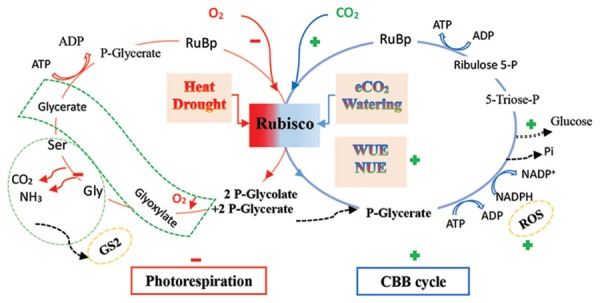FIGURE 1.

A diagrammatic outline of the Calvin–Benson–Basshan (CBB) cycle and photorespiration pathway in plants in response to elevated CO2 with abiotic factors. Rubisco has two sites of carboxylation and oxygenation. Elevated CO2 (eCO2) may promote carboxylation, but repress oxygenation under ample environmental conditions, such as well-watering, whereas extreme abiotic stress, such as heat and drought, may repress carboxylation but promote oxygenation (Wingler et al., 1999; Tingey et al., 2003). An energy consumption trade-off between the key cycles may occur, possibly modified by the CO2 level, in which photorespiration may be promoted to quench reactive oxygen species (ROS), related to glutamine synthetase (GS2) to recycle ammonia, diminishing photo-oxidation and photo-inhibition (dotted orange line ellipse; Kozaki and Takeba, 1996; Watanabe et al., 2014). A low Gly:Ser ratio provides evidence that photorespiration is repressed in eCO2 (Kebeish et al., 2007). Water use efficiency (WUE) and nitrogen use efficiency (NUE), despite the N dilution, should be enhanced by elevated CO2, by decreasing stomatal conductance and investing relatively more N into the Rubisco protein (Palmroth et al., 2013). The photorespiration process is compartmentalized into the chloroplast (red line ellipse), peroxisome (dotted green line bent rectangle), and mitochondrion (dotted green line ellipse). The green plus and red minus signs denote the stimulation and suppression via rising CO2, respectively (mainly referring to Kozaki and Takeba, 1996; Wingler et al., 1999; Tingey et al., 2003; Ainsworth and Rogers, 2007; Moroney et al., 2013; Xu et al., 2013a; Watanabe et al., 2014).
